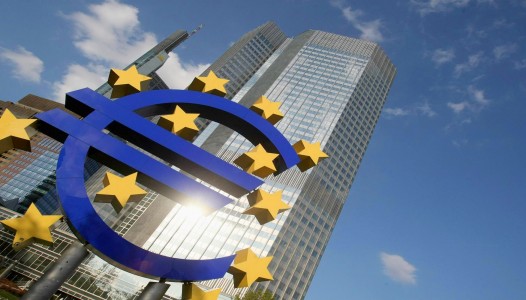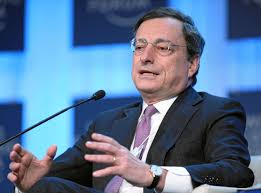With the launch of euro zone quantitative easing on January 22, European Central Bank President Mario Draghi hopes to have delivered on his pledge to do “whatever it takes” to safeguard the region’s prospects. It was not quite a design classic but it was a feat of engineering nevertheless. The quantitative easing programme unveiled by ECB President Mario Draghi on last Thursday was – save for a few missing components – a pretty impressive machine.
Euro zone QE certainly compares favourably with the versions assembled in the US, Japan and UK, especially when it comes to its size and scope. By buying bonds at a monthly rate of EUR60 billion until at least September 2016, the ECB will expand its balance sheet by more than 50 per cent to above EUR3 trillion. At that point, the central bank’s bond purchases will net out to some 19 per cent of the region’s GDP, a stimulus similar in magnitude to that of the US Federal Reserve and Bank of England, which plateaued at about 20 per cent. The maturity range of the QE programme – from two right through to 30 years – is another plus, as are the central bank’s proposals to buy inflation-linked debt and to potentially add to its holdings of asset-backed and covered bonds. (The inclusion of linkers was an important element. Had these instruments been excluded, nominal bonds would probably have outperformed their inflationlinked counterparts, resulting in a lower breakeven inflation rate, which is the opposite of what the ECB wishes to achieve).
Timing almost as important as size
Critics might say that size isn’t everything. The evidence from the UK, US and Japanese QE experiments suggests that no matter how low government borrowing costs go, policymakers cannot easily engineer a revival in bank lending, which is what the euro zone desperately needs to avoid a deflationary spiral. The fact that bond yields were already at all-time lows before the latest stimulus package makes this task all the more difficult. Yet, while painfully long in the making, Draghi’s grand plan could arguably have not have arrived at a much better time for the banking sector. Demand for credit among European households has been rising for some months now. Our analysis of underlying trends in the ECB’s Bank Lending Survey indicates that consumer appetite for credit is building to such an extent that household loan growth could rise to some 3 to 5 per cent next year – and that is before the effects of QE are taken into account. Adding QE into the mix, private lending could be about to see more sustainable growth.
Squeezing the EUR
The programme’s chances of success are perhaps even greater in the currency markets. Another of Draghi’s aims is to weaken the EUR and – through that – trigger an export-driven recovery and a rise in imported inflation. So far, the ECB president will have been encouraged by what he has seen. The EUR has lost some 3.5 per cent on a trade-weighted basis since its peak in March last year and is now trading close to its fair value. The depreciation is unlikely to end there. Currencies that slip into a depreciation pattern have a tendency to break substantially below their fair value – a typical overshoot is around one standard deviation. For the EUR, this would mean a further depreciation of some 6 per cent on a tradeweighted
basis, which would boost economic growth by about 0.7 percentage points.
Risk-sharing concerns
But, as with many things crafted in the euro zone, there are some design flaws that might cause engine trouble. Bowing to the conditions set by the German Bundesbank, sovereign bond purchases will not be made according to the normal risk-sharing agreements of the ECB, under which investment losses are shared among the region’s 19 central banks in proportion to the size of their economies. Instead, national central banks will be responsible for buying the lion’s share of their governments’ bonds and shoulder 80 per cent of any investment loss. In our view, this concession to Germany is a concern – QE with full risk sharing would undoubtedly have been more effective. Even so, as Draghi himself pointed out, national central banks’ capital buffers are large enough to withstand possible investment losses. Take Italy as an example. The Bank of Italy’s buffer – its capital reserves, provisions and revaluation account – amounts to EUR100 billion while its purchases of Italian government debt under QE through to 2016 will be not far above that at EUR140 billion.
Investment implications
It is important to note that the ECB is just one of a number of central banks shifting to a more dovish/less hawkish stance. The Bank of Canada and the People’s Bank of China have recently cut interest rates while the Bank of Japan may look to expand its monetary stimulus programme in 2015. The Bank of England has also become more dovish in recent weeks. This monetary stimulus, coupled with expectations for a pick-up in growth, should make for a benign investment environment. Europe’s equity markets should gain weeks disproportionately from the ECB’s QE drive, provided the political climate in the region remains stable. Over the past few months, European stocks have not seen either a pick-up in profit growth or an expansion in earnings multiples, so there is plenty of scope for both to materialise over the medium term. Corporate earnings growth of some 15-16 per cent this year looks achievable. Financial and cyclical stocks should also fare well. The EUR should continue to depreciate, particularly against the USD and emerging currencies. Higher yielding debt – European high-yield and emerging market bonds – may also see increased demand as their yields will become more attractive.
Source : Pictet




